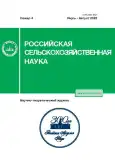Assessment of the adaptability of spring film oats in terms of yield and grain quality in the conditions of the Kirov region
- Autores: Vologzhanina E.N1, Batalova G.A1
-
Afiliações:
- Federal Agricultural Research Center of the North-East named N.V. Rudnitsky
- Edição: Nº 4 (2023)
- Páginas: 8-12
- Seção: Articles
- URL: https://journals.rcsi.science/2500-2627/article/view/141876
- DOI: https://doi.org/10.31857/S2500262723040026
- EDN: https://elibrary.ru/JXAKVR
- ID: 141876
Citar
Texto integral
Resumo
Palavras-chave
Sobre autores
E. Vologzhanina
Federal Agricultural Research Center of the North-East named N.V. Rudnitsky
Email: helen.vol@list.ru
610007, Kirov, ul. Lenina, 166 A
G. Batalova
Federal Agricultural Research Center of the North-East named N.V. Rudnitsky610007, Kirov, ul. Lenina, 166 A
Bibliografia
- Изменение урожайности и качества зерна овса с повышением адаптивности сортов / О. А. Юсова, П. Н. Николаев, И. В. Сафонова и др. // Труды по прикладной ботанике, генетике и селекции. 2020. № 181 (2). С. 42-49. doi: 10.31367/2079-8725- 2021-74-2-75-80.
- "Тоболяк" - сорт овса ярового универсального использования / М. Н. Фомина, Ю. С. Иванова, О. А. Пай и др. // Труды по прикладной ботанике, генетике и селекции. 2021. Т. 182. № 2. С. 107-113. doi: 10.30901/2227-8834-2021-2-107-113.
- Фомина М. Н., Брагин Н. А. Влияние элементов технологии на реализацию биологического ресурса у сортов овса нового поколения в зоне северной лесостепи Тюменской области // Достижения науки и техники АПК. 2020. Т. 34. № 3. С. 22-25. doi: 10.24411/0235-2451-2020-10304.
- Бездогов А. В., Ялунина А. Д. Оценка сортов голозёрного овса по продуктивности и реакции на климатические условия Среднего Урала // Интерактивная наука. 2016. № 10. С. 94-101. doi: 10.21661/r-114765.
- Власов А. Г., Халецкий С. П., Булавина Т. М. Адаптивные свойства и особенности формирования урожайности сортов овса белорусской селекции // Вестник Марийского государственного университета. Серия: сельскохозяйственные науки. Экономические науки. 2020. Т. 10. № 4 (24). С. 397-405. doi: 10.30914/2411- 9687-2020-6-4-397-404.
- Адаптивный потенциал образцов овса по химическим и физическим характеристикам зерна / В. И. Полонский, С. А. Герасимов, А. В. Сумина и др. // Труды по прикладной ботанике, генетике и селекции. 2022. № 183 (1). С. 57-75. doi: 10.30901/2227-8834-2022-1-57-75.
- Кардашина В. Е., Николаева Л. С. Агроэкологическая оценка сортов и перспективных линий овса универсального использования // Достижения науки и техники АПК. 2020. Т. 34. № 5. С. 56-60. doi: 10.24411/0235-2451-2020-10511.
- Оценка адаптивных параметров коллекционных образцов овса плёнчатого по урожайности в условиях Кировской области / М. В. Тулякова, Г. А. Баталова, И. Г. Лоскутов и др. // Труды по прикладной ботанике, генетике и селекции. 2021. № 182 (1). С. 72-79. doi: 10.30901/2227-8834-2021-1-72-79.
- Параметры пластичности и стабильности сортов озимой твёрдой пшеницы по различным предшественникам в условиях Ростовской области / А. В. Алабушев, Т. С. Макарова, Н. Е. Самофалова и др. // Аграрная наука Евро-Северо-Востока. 2019. № 20 (6). С. 557-566. doi: 10.307766/2072- 9081.2019.20.6.557-566.
- Пакудин В. З., Лопатина Л. М. Оценка экологической пластичности и стабильности сортов сельскохозяйственных культур // Сельскохозяйственная биология. 1984. № 4. С. 109-113.
- Плохинский Н. А. Биометрия. Новосибирск: Изд-во СО АН ССР, 1961. 364 с.
- Селянинов Г. Т. О сельскохозяйственной оценке климата // Труды по сельскохозяйственной метеорологии. 1928. Вып. 20. С. 165-177.
- Хангильдин В. В. О принципах моделирования сортов интенсивного типа // Генетика количественных признаков сельскохозяйственных растений. М.: Наука, 1978. С. 111-116.
- Methodology of Breeding Ecologically Resistant Varieties of Oats / G. A. Batalova, S. N. Shevchenko, E. M. Lisitsyn, et al. // Russian Agricultural Sciences. 2018. Vol. 44. No. 1. P. 3-6. doi: 10.3103/S1068367418010068.
- Баталова Г. А. Овес в Волго-Вятском регионе. Киров: ООО "Орма", 2013. 288 с.
- Вологжанина Е. Н., Баталова Г. А. Новые перспективные сорта и линии пленчатого и голозерного овса укосного и универсального направления // Российская сельскохозяйственная наука. 2022. № 4. С. 3-7. doi: 10.31857/S2500262722040019.
Arquivos suplementares









